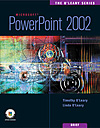 |  Office XP PowerPoint 2002, 2/e Timothy O'Leary,
Arizona State University
Creating a Presentation
Concepts
Lab 1: Creating a Presentation
The following concepts will be introduced in this tutorial: - Template: A template is a file that includes predefined settings that can be used as a pattern to create many common types of presentations.
- Presentation Styles: A PowerPoint presentation can be made using five different styles: onscreen presentations, Web presentations, black-and-white or color overheads, and 35mm slides.
- Slide: A slide is an individual ìpageî of your presentation. The first slide of a presentation is the title slide. Additional slides are used to support each main point in your presentation.
- AutoCorrect: The AutoCorrect feature makes some basic assumptions about the text you are typing and, based on these assumptions, automatically identifies and/or corrects the entry.
- Spelling Check: The automatic spelling checker feature advises you of misspelled words as you create and edit a presentation, and proposes possible corrections.
- Layout: PowerPoint includes 27 predefined slide layouts that can be selected and applied to slides.
- Font: A font is a set of characters with a specific design. Using fonts as a design element can add interest to your presentation and give your audience visual cues to help them find information quickly.
- Graphics: A graphic is a non-text element or object, such as a drawing or picture, that can be added to a slide.
- Stacking Order: Stacking order is the order objects are inserted in the different layers of the slide. As each object is added to the slide, it is added to the top layer.
|
|




 2002 McGraw-Hill Higher Education
2002 McGraw-Hill Higher Education